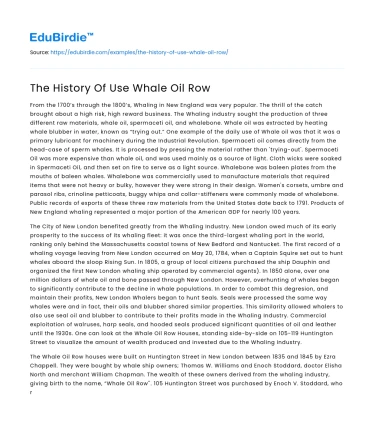From the 1700’s through the 1800’s, Whaling in New England was very popular. The thrill of the catch brought about a high risk, high reward business. The Whaling industry sought the production of three different raw materials, whale oil, spermaceti oil, and whalebone. Whale oil was extracted by heating whale blubber in water, known as “trying out.” One example of the daily use of Whale oil was that it was a primary lubricant for machinery during the Industrial Revolution. Spermaceti oil comes directly from the head-case of sperm whales. It is processed by pressing the material rather than 'trying-out'. Spermaceti Oil was more expensive than whale oil, and was used mainly as a source of light. Cloth wicks were soaked in Spermaceti Oil, and then set on fire to serve as a light source. Whalebone was baleen plates from the mouths of baleen whales. Whalebone was commercially used to manufacture materials that required items that were not heavy or bulky, however they were strong in their design. Women's corsets, umbre and parasol ribs, crinoline petticoats, buggy whips and collar-stiffeners were commonly made of whalebone. Public records of exports of these three raw materials from the United States date back to 1791. Products of New England whaling represented a major portion of the American GDP for nearly 100 years.
The City of New London benefited greatly from the Whaling Industry. New London owed much of its early prosperity to the success of its whaling fleet: it was once the third-largest whaling port in the world, ranking only behind the Massachusetts coastal towns of New Bedford and Nantucket. The first record of a whaling voyage leaving from New London occurred on May 20, 1784, when a Captain Squire set out to hunt whales aboard the sloop Rising Sun. In 1805, a group of local citizens purchased the ship Dauphin and organized the first New London whaling ship operated by commercial agents). In 1850 alone, over one million dollars of whale oil and bone passed through New London. However, overhunting of whales began to significantly contribute to the decline in whale populations. In order to combat this degresion, and maintain their profits, New London Whalers began to hunt Seals. Seals were processed the same way whales were and in fact, their oils and blubber shared similar properties. This similarity allowed whalers to also use seal oil and blubber to contribute to their profits made in the Whaling Industry. Commercial exploitation of walruses, harp seals, and hooded seals produced significant quantities of oil and leather until the 1930s. One can look at the Whale Oil Row Houses, standing side-by-side on 105-119 Huntington Street to visualize the amount of wealth produced and invested due to the Whaling Industry.
Save your time!
We can take care of your essay
- Proper editing and formatting
- Free revision, title page, and bibliography
- Flexible prices and money-back guarantee
The Whale Oil Row houses were built on Huntington Street in New London between 1835 and 1845 by Ezra Chappell. They were bought by whale ship owners; Thomas W. Williams and Enoch Stoddard, doctor Elisha North and merchant William Chapman. The wealth of these owners derived from the whaling industry, giving birth to the name, “Whale Oil Row''. 105 Huntington Street was purchased by Enoch V. Stoddard, who ran a whaling firm with two schooners. Enoch Stoddard was born on September 14, 1804. Stoddard was a very important individual and has left a lasting impact on the whaling industry. He was first married to Mary Allen in 1832, and then re-married to Sarah Allen in 1849. Stoddard had 4 children and died February 3, 1873 at the age of 68. 105 Huntington Street is wider than the others Whale Oil Row homes. Pilasters mark both corners. 111 Huntington Street was purchased by Elisha North. North was born in Goshen, Connecticut, on January 8th, 1771. He attended school for only a short period of time, and at an early age began studying medicine with his father who was a farmer as well as a doctor. In 1817, North opened an eye infirmary in New London, with the hope of increasing his knowledge by advertising to the public in regard to his eye institution. After the terrible outbreak of the disease in 1829, North published the book, “Outlines of the Sciences of Life”.
111 Huntington Street has two mullions in quarter circle and circular pattern, while the frame appears to duplicate that of 119 Huntington Street with mouldings and a boxed anthemion motif. 115 Huntington Street was purchased by Thomas Williams. Williams was a Stonington native. Williams was born in September of 1789, clerked in New York City for a time, and was involved in shipping business for about 8 years before he moved to New London. Williams was an incorporator of a savings bank, president of the New London, Willimantic, and Springfield Railroad Company, and a member of Congress from 1839-1843. Williams owned 10 whaling ships and is credited with getting the ball rolling on outfitting ships for whaling and turning New London into that prominent whaling port that the majority is familiar with today. 115 Huntington Street is topped by a bracketed flat pediment and has mullions in oval and circular patterns. 119 Huntington Street was purchased by William H. Chapman, Head of E.C. Chapman, Drygoods, 15 State Street and later president of the Union Bank. 119 Huntington Street has flat mullions and boxed low relief carvings of the anthemian. The architectural style of Whale Oil Row allows these homes to stand out from the crowd. These homes illustrate the grand lifestyle and wealth that whaling produced and attracted to the city of New London. Today, Individual’s drive by and view Whale Oil Row as office buildings, however, these homes are ingrained with a rich history and will always be connected to the Whaling industry.






 Stuck on your essay?
Stuck on your essay?

